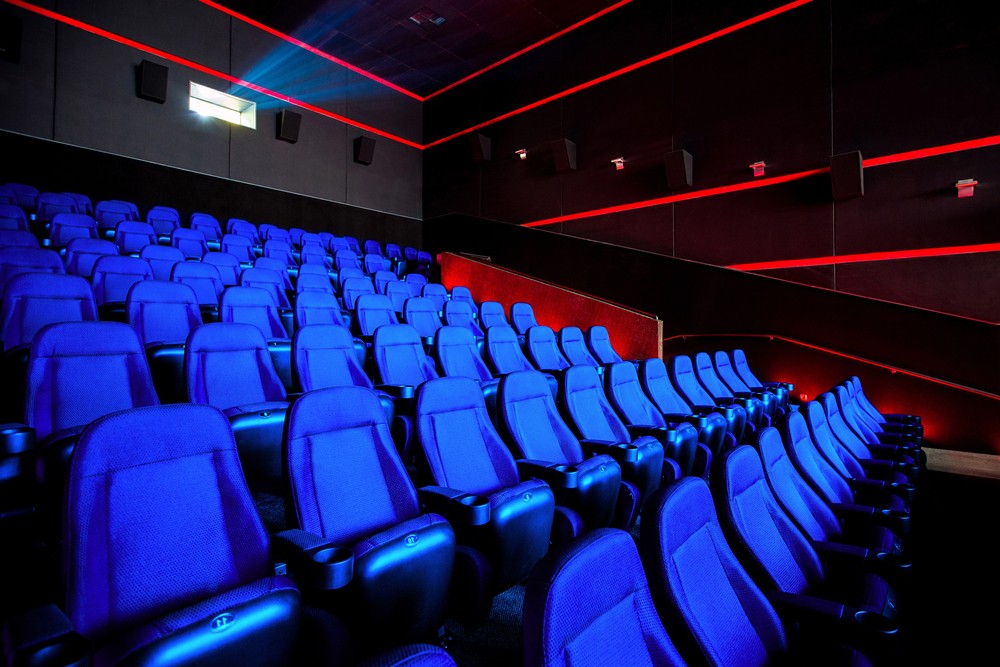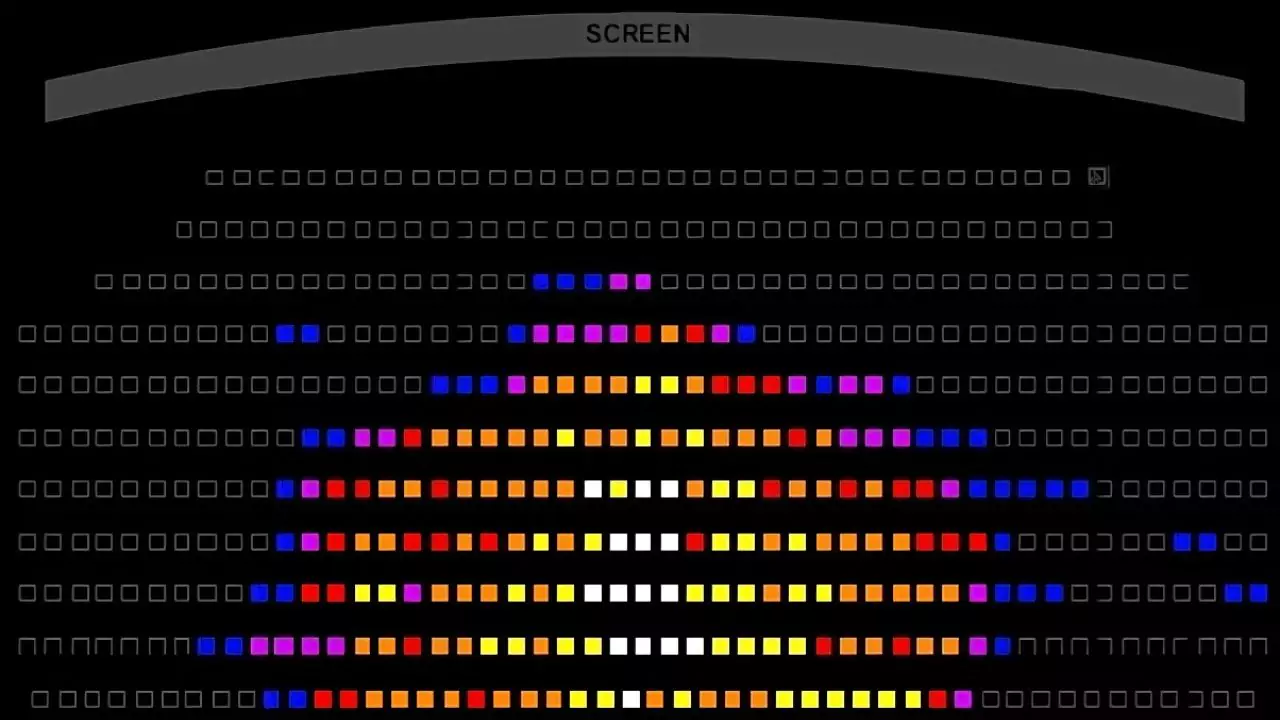The best seat in an IMAX cinema is in the center, both horizontally and vertically, four or five rows from the rear.
This will offer you the finest visual and sound quality with the least distortion. Avoid sitting too near to the screen or in the corners for a poor 3D experience.
However, your preference may also affect your seat decision, so try several alternatives to determine what works best for you.
What’s Special About an IMAX Theater?

An IMAX theater is not just a bigger screen. It is a whole different way of watching movies, with several features that make it stand out from a regular theater. Here are some of them:
1. Keystone Distortion
Keystone distortion is when the image on the screen appears distorted or skewed because of the angle of projection.
When the screen is curved or inclined or the projector is not aligned with the center, this occurs.
IMAX theaters use special projectors that are aligned with the center of the screen, and flat screens that are perpendicular to the floor. This eliminates keystone distortion and ensures a clear and accurate image.
2. IMAX Sound System
IMAX theaters boast an exclusive sound system, providing sharp and potent audio from every direction. This arrangement deploys six audio channels – left, center, right, left surround, right surround, and subwoofer – to achieve harmony with the screen visuals. Positioning of speakers occurs behind the screen and around the theater boundaries, establishing a 3D audio environment that immerses viewers in the cinematic experience. The subwoofer emits low-frequency sounds, leading to a palpable sensation in the audience’s chest.
3. IMAX Projectors
IMAX theaters use two projectors to provide a bright, crisp picture. The projectors employ 70mm film or digital technology depending on the movie format. Film projectors can display pictures up to 10 times bigger than 35mm film projectors, whereas digital projectors may display images up to 4K quality (4096 x 2160 pixels). Projectors employ polarized filters to divide light into two streams that reach your eyes via special glasses to generate 3D effects.
4. IMAX Screens
IMAX screens are 50–100 feet wide and 30–80 feet high. They’re closer to the crowd, too. Sound passes via perforated metal screens. They’re silver-coated to reflect more light.
Ideal Seat Placement in an IMAX Theater
Now that you know what makes an IMAX theater special, let’s talk about how to choose the best seat in one. Here are some general guidelines:
- Center of the theater, both horizontally and vertically: The finest view of the screen without distortion or angle concerns is in the theater’s center. You’ll receive the optimum sound balance from all channels.
- Two-thirds of the way back from the screen: This is the best distance without being too near or too distant. You’ll see everything without straining.
- Avoid sitting too close or too far away: Sitting too near to the screen might create eye strain or lead you to miss sections of the display. You’ll miss details if you’re too far away.
- Avoid sitting on the far right or left corners: Sitting on these seats will give you a poor 3D experience, as the image will appear slanted or blurry. You will also get a distorted sound from one side.
The Importance of Keystone Distortion and Lateral Positioning
Keystone distortion and lateral positioning are two factors that can affect your viewing experience in an IMAX theater. Here is why they are important and how to avoid them:
Ensuring a distortion-free image
Keystone distortion occurs when the projection angle distorts the screen picture. When the screen is curved or inclined or the projector is not aligned with the center, this occurs. Flat screens and unique projectors are used in IMAX cinemas. This reduces keystone distortion and guarantees a sharp picture.
If you sit on the extreme right or left corners of the theater, the picture may look tilted or stretched, causing keystone distortion. To prevent this, sit towards the theater’s center horizontally and vertically.
Choosing a seat with optimal viewing angles
Lateral positioning is your left-to-right distance from the screen center. This impacts viewing angle and screen coverage. IMAX displays are enormous and close to the audience, thus sitting on the edges might create eye strain or miss sections of the show.
To prevent this, sit towards the theater’s center horizontally and vertically. This provides the optimal viewing angle and lets you see the complete screen without shifting your head or eyes.
Does Lateral Positioning Matter?
Lateral positioning matters because it affects your viewing angle and how much of the screen you can see. IMAX screens are very large and close to the audience, so sitting on the edges can make you miss some parts of the image or cause eye strain.
To prevent this, sit towards the theater’s center horizontally and vertically. This provides the optimal viewing angle and lets you see the complete screen without shifting your head or eyes.
Does Sitting in the Front or Back Matter?
Sitting at the front or rear of an IMAX cinema is a personal choice with perks and downsides. Some are:
- Sitting in the front: The picture will fill your vision, making it more immersive. It may also create neck or eye strain since you have to move your head and eyes to view the complete screen. You may potentially overlook details or distort 3D.
- Sitting in the back: You can view the full screen without straining your eyes or neck. The image’s depth may improve 3D effects. The picture will be smaller and farther away, which may make you feel alienated from the movie.
To avoid visual distortion and receive the finest sound, sit towards the theater’s left-to-right midline.
Should I Sit in the Front Row?
Unless you want an extraordinary experience, don’t sit in an IMAX theater’s front row. Being near the screen in the front row may produce eye strain, neck aches, or nausea. You may also see distorted 3D or miss sections of the picture.
If you want to sit in the front row, prepare for these inconveniences and wear comfortable clothing and shoes. Eating or drinking before or during the movie may make you ill.
How to Find the Center of the Theater?
Following these instructions will help you locate the IMAX theater’s center:
- Draw two diagonal lines across the theater.
- Find where these lines intersect. This is the center of the theater.
- Book a seat near this point, both horizontally and vertically.
The center of an IMAX theater is where you will get the best view and sound quality, with no distortion or angle issues.
What Makes IMAX Sound Unique?
IMAX’s patented sound technology offers clear, powerful sound from all angles. Six sound channels—left, center, right, left surround, right surround, and subwoofer—synchronize with the screen picture. Speakers behind the screen and surrounding the theater walls create a 3D sound environment that immerses you in the film. Low-frequency subwoofer noises are felt in the chest.
IMAX sound makes movies more immersive. Dialogue, sound effects, and music are clear and loud. Sound sources may be identified, offering a realistic and immersive experience.
Final Thoughts About the Best IMAX Seats
Choosing the perfect IMAX seat might improve your movie experience. Sit in the center of the theater, horizontally and vertically, four or five rows from the rear. This provides the finest sound and visual quality with little distortion. Avoid sitting too near or far from the screen or on the extreme right or left corners for a poor 3D experience.
FAQs
Here are some frequently asked questions about IMAX theaters and seats:
How early should I buy IMAX tickets?
If you want the finest IMAX seats, book early. IMAX cinemas sell out rapidly, particularly for new titles and blockbusters. Seats may be reserved online, via phone, or at the box office.
Is it worth paying extra for IMAX?
If you want an immersive, amazing movie experience, IMAX tickets are worth the extra cost. IMAX cinemas have a bigger screen, greater sound, sharper pictures, and 3D impact. IMAX movies are structured and designed for IMAX screens so you can see more details and experience the movie as the producers intended.
Can I bring my own 3D glasses to an IMAX theater?
You cannot bring your own 3D glasses to an IMAX cinema. IMAX cinemas employ 3D glasses developed for IMAX screens and projectors. By dividing light into two streams that reach your eyes via the glasses, polarizing filters generate 3D effects. Bringing your own 3D glasses may cause headaches or eye strain. The cinema may provide free or low-cost IMAX 3D glasses.



